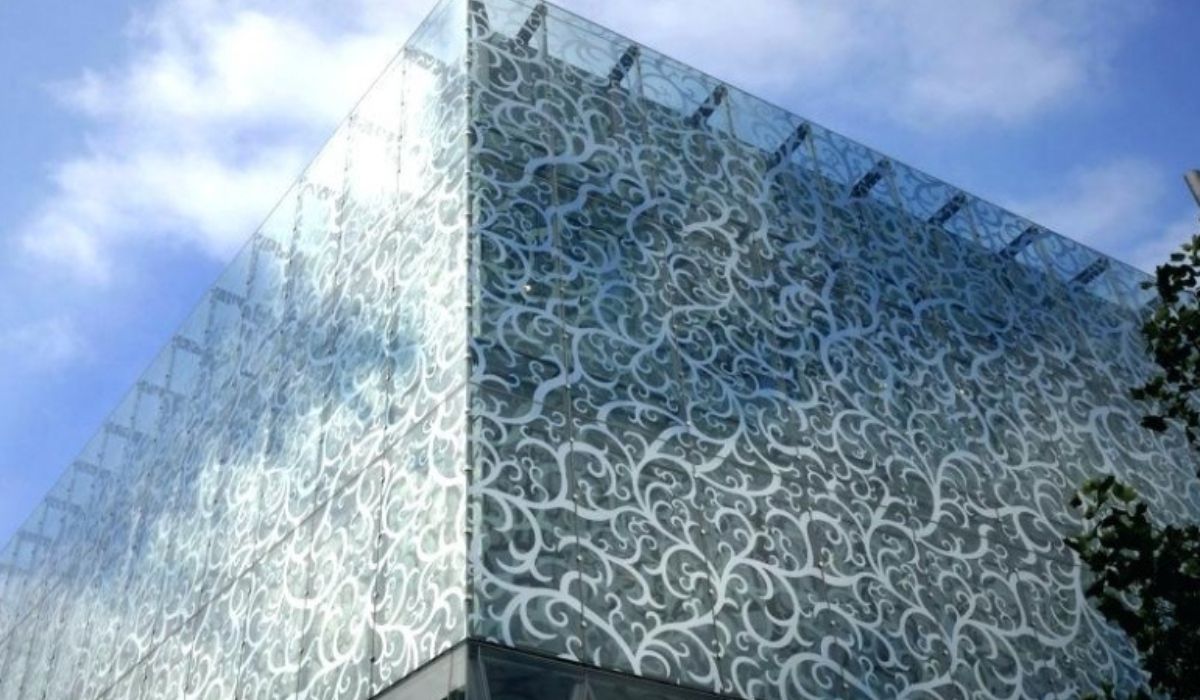Fritted glass has quickly become an industry leader in the cutting edge world of contemporary architecture. From its definition and uses to its advantages and disadvantages, this page tries to shed light on all aspects of frittedglass.
What is Fritted Glass
Fritted glass is a subset of the glass family with a finely textured surface obtained through the application of a ceramic frit substance during the manufacturing process. During the high-temperature fusing process, this frit, which is effectively a powdered glass enamel, becomes fused onto the surface of the glass. The end result is a piece of glass with aesthetic value and practical benefits.
How is Fritted Glass Made
The process of making frittedglass is quite precise. The required glass sheet is initially made. The glass is subsequently coated with ceramic frit, which varies in color and opacity. Silk-screening and roller application are two viable options for accomplishing this. High temperatures are applied to the glass, permanently fusing the frit with the glass to produce the desired texture or pattern.
Advantages of Fritted Glass
There are a plethora of benefits to using fritted glass. It shields you from prying eyes by blocking their vision, but doesn’t block out the sun entirely. The rough surface softens the lighting by scattering the incoming rays. In addition, architects and designers have virtually limitless options when working with frittedglass because of its adaptability in terms of pattern and opacity.
Applications in Modern Architecture
Because of its adaptability, frittedglass may be used in many different ways in contemporary building design. It’s commonly used for windows, skylights, glass walls, and curtain walls. For both business and home use, it strikes the perfect blend of aesthetics, practicality, and privacy.
Fritted Glass vs. Traditional Glass
Frittedglass stands out from plain old transparent glass because it conceals your belongings without blocking off the sun. For privacy, traditional glass may need to be treated in a way that compromises its aesthetic value. In contrast, frittedglass can be used for both decorative and practical applications.
Enhancing Privacy with FrittedGlass
When designing a building, privacy must always be a top priority. Fritted glass fills this void by providing a range of opaqueness options. Glass can be fritted to varying degrees, providing more or less privacy depending on the situation.
Fritted Glass in Interior Design
Fritted glass is not only used in architecture, but also in interior decoration. It has a wide variety of applications, including partitions, stairways, and bathrooms. It’s a blessing for interior design because it can improve the look of a room while not sacrificing any practicality.
Sustainability and Fritted Glass
Fritted glass is still a viable option in this day and age of eco-awareness. Because of its ability to diffuse natural light, ceramic frit can help conserve energy by lowering the need for artificial lighting, and it can be made with environmentally benign ingredients.
Maintaining and Cleaning FrittedGlass
Maintenance is key to extending the life of fritted glass. Cleaning should be done frequently using nonabrasive products and mild detergents. The textured surface may require more maintenance than regular glass, but the enhancements to both form and function are well worth the effort.
Innovative Trends in FrittedGlass Usage
Fritted glass’s use shifts along with shifting aesthetic preferences. Fritted glass has been used in architecture for a long time, and it continues to push the envelope with its variety of uses.
Challenges and Considerations
There are many positives to using fritted glass, but there are also some drawbacks that must be considered. The surface is fragile and might easily scratch, and striking the correct balance between form and function is tricky.
Future Potential of FrittedGlass
Fritted glass appears to have a bright future. Frittedglass is likely to advance further, bringing even more novel answers to contemporary design difficulties, as architects and designers experiment with new processes and materials.
Conclusion
Frittedglass is a prime example of how form and function can harmoniously coexist in modern building and decor. Given its versatility as a privacy screen, light diffuser, and aesthetic enhancer, it has become a sought-after material.
Frequently Ask Questions (FAQs)
Can frittedglass be used in outdoor applications?
Frittedglass is long-lasting and resistant to the elements, making it ideal for use in exterior settings.
Is frittedglass energy-efficient?
Natural light can be diffused by frittedglass, helping to reduce the need for artificial lighting and saving energy.
Can I create custom patterns with frittedglass?
In a word, yes! Frittedglass allows you a great deal of personalization, since you may make designs that are completely unique to your project.
Does frittedglass require specialized cleaning?
Regular cleaning of frittedglass is necessary, however it can be done with just nonabrasive materials and gentle detergents.
Where can I find frittedglass for my project?
Consult with architects who have worked with frittedglass before or look into finding a specialized glass source.











